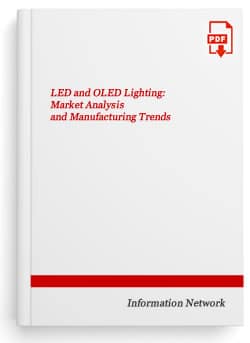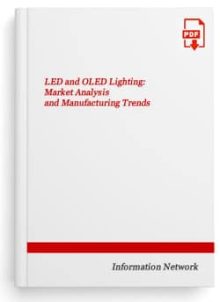Description
The High Brightness Light Emitting Diode (HB LED) market is exploding as unit shipments continue their upward growth. LEDs are creating a niche market for conventional suppliers of semiconductor processing tools. Markets for HB LEDs, backlight LEDs, and OLEDs are forecast.
TABLE OF CONTENTS
LED and OLED Lighting: Market Analysis and Manufacturing Trends
Chapter 1: Introduction
Chapter 2: Recent Progress in High Brightness LED Technology and Applications
2.1. LED: Theory of Operation
2.2. Intellectual Property Map
2.3. LED Manufacturing Technologies & Costs
2.4. LED Market General Illumination
Chapter 3: Processing Equipment
3.1. Introduction
3.2. Deposition
3.2.1. MOCVD for SSL – Productivity Challenges and Solutions
3.2.2. Low temperature Remote Plasma Chemical Vapor Deposition (RPCVD)
3.3. Chemical Mechanical Planarization
3.4. Defect Inspection and Testing
3.5. Lithography
3.5.1. Steppers
Chapter 4: Materials of Construction
4.1. Introduction
4.2. GaN-based LED for General Lighting
4.2.1. Methods to Improve White LED Efficiency
4.2.2. Time-to-Market for LED substrates
4.3. LED Phosphor Manufacturing Issues
4.3.1. Current LED Phosphor Manufacturing
4.3.2. LED Phosphor Cost
Chapter 5: Packaging and Assembly Issues for High Brightness LEDs
5.1. Packaging for HB LEDs
5.1.1. Bonding
5.1.2. Die/Ball Bonding
5.1.3. Scribing
5.2. Wafer Level Packaging HB LEDs
5.3. Thermal Issues
5.4. Test and Inspection
Chapter 6: National Programs As Innovation Drivers
6.1. DOE Solid-State Lighting Manufacturing Initiative
6.2. DOE Solid-State Lighting Program Mission and Goal
6.3. Major National Research Programs Pertaining to LEDs
6.4. Challenges Facing SSL Manufacturing
Chapter 7: OLED Lighting
7.1. Opportunities for Luminaire Manufacturers
7.2. How Does an OLED Work
7.3. Differences Between OLED Lighting and OLED Display
7.4. Benefits of OLED Lighting Technology
7.5. OLED Performance Metrics
Chapter 8: OLED Manufacturing
8.1. Deposition Equipment and Processes for OLED Lighting
8.1.1. Vacuum Deposition Or Vacuum Thermal Evaporation (VTE)
8.1.2. Organic Vapor Deposition (OVPD)
8.1.3. Inkjet Printing
8.1.4. Roll-to-Roll (R2R)
8.2. General OLED Manufacturing Cost Considerations
8.3. Lithography
8.4. Substrates and Encapsulation
8.4.1. Substrate and Encapsulation Material Selection
8.4.2. Substrate Coatings
8.4.3. Transparent Electrodes
8.4.4. Encapsulation
8.5. Inspection and Quality Control
Chapter 9: Outlook for the Worldwide OLED Market
9.1. Introduction
9.2. Passive Matrix Capacity and Demand
9.3. Active Matrix Capacity and Demand
9.4. Cost Challenges for OLED Lighting
Chapter 10: Outlook for the Worldwide High-Brightness LED Market
10.1. HB LED Technology
10.2. HB LED Market Overview and trends
10.2.1. Market Drivers for SSL
10.2.2. LED Backlights for Notebook PCs
10.2.3. LED Backlights for LCD TVs
10.2.4. LED Backlights for Other Applications
10.2.5. LED Lighting Market
10.2.6. LED Active Outdoor Display Market
10.2.7. LED Signal Market
10.2.8. LED Automotive Market
10.2.9. LED Mobile Market
List of Tables
2.1. Color, Wavelength Material Of LED
2.2. Light Source Comparison
2.3. Comparison of LED, HB-LED, UHB-LED Characteristics
3.1. Epitaxy Metrics from Initial Solid-State Lighting Manufacturing R&D Roadmap
3.2. Process Control Metrics
4.1. Production Method for Various LEDs
4.2. LED Cost Model: Impact of Substrate Choice
4.3. Comparison of $/klm for LED Made on Various 2″ Substrates
5.1. Properties of Die Bonding Processes
7.1. Efficiency of Emitter Materials
7.2. Status of Technology Towards Lighting Targets
7.3. Cost Targets for Panels
7.4. Cost Comparison OLED Display vs Lighting
8.1. Cost Targets for Panels Produced by Traditional Methods
10.1. Forecast of LED Backlights for Notebook PCs
10.2. Forecast of LED Backlights for LCD TVs
10.3. Forecast of LED Backlights for Other Application
10.4. Forecast of LED Lighting Market
10.5. Forecast of LED Active Outdoor Display Market
10.6. Forecast of LED Signal Market
10.7. Forecast of LED Automotive Market
10.8. Forecast of LED Mobile Market
10.9. Top 10 LED Vendors
List of Figures
2.1. Operation of LED
2.2. Key Intellectual Property Relationships
2.3. DOE Roadmap
2.4. Relative Manufacturing Costs
2.5. Pareto Analysis Of SSL Manufacturing Costs
2.6. Market drivers for LED Biz and Applications
2.7. SSL vs. Classical Technologies
2.8. LED Performance vs. Traditional Light Sources
2.9. Energy Production and Use Comparison
2.10. Worldwide LED Market Forecast
3.1. SSL – LED manufacturing with MOCVD: productivity and Cost Analysis
3.2. Larger Wafer Size: GaN LEDs
3.3. Global Shipments of MOCVD Tools By Vendor
3.4. Global Shipments of MOCVD Tools By Region
3.5. Diagram of RPCVD Reactor
3.6. Comparison between MOCVD and RPCVD
3.7. CMP Process
3.8. Nanoimprint Lithography System
3.9. The Phlatlight Chip
4.1. Regular LED (white) Front-End Steps
4.2. Current Blocking Layer
4.3. Regular LED (white) Production Costs for 100k wafers/year
4.4. HB LED (white) Production Costs for 100k wafers/year
4.5. Main Manufacturing Steps for GaN-based LED
4.6. Regular LED (white) Back-End
4.7. Methods to Improve White LED Efficiency
4.8. Phosphor Coating – Four Approaches
5.1. Hybrid Integration Approach to HD-LED Package
5.2. Chain Wire Bond
5.3. HB-LED with Silicon Carrier Submount
5.4. Silicon interposer for MEMS / LED Applications
5.5. High Brightness LED
5.6. SMD Package Cost Structure
5.7. Packaging Changes Result in Optical Improvements
5.8. Substrate Solutions for HB/HP LEDs
6.1. DOE Solid-State Lighting Program Strategy
6.2. DOE Efficacy Targets
6.3. Congressional Appropriations
6.4. SSL R&D Project Funding
6.5. Price Targets
7.1. OLED Lighting Stack
8.1. Schematic of VTE Deposition System
8.2. Schematic of OVPD Deposition System
8.3. Comparison Between VTE and OVPD Technology
8.4. Schematic of Inkjet Deposition System
8.5. Schematic of R2R Deposition System
8.6. Illustration of Planarization Layer on OLED
9.1. Schematic of PMOLED
9.2. PMOLED Stack/Driving Architecture
9.3. Schematic of AMOLED
9.4. Passive Matrix OLED Capacity and Demand
9.5. Active Matrix OLED Capacity and Demand
10.1. LED Market by Sector
10.2. Worldwide LED Market Forecast

